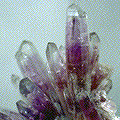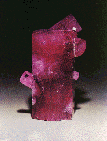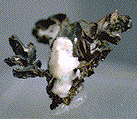For natural garnet mineral specimens, select any of the mineral names above.
Garnets as a group are relatively common in highly metamorphosed rocks and in some igneous formations. They form under the high temperatures and/or pressures that those types of rocks must endure. Garnets can be used by geologists as a gauge of how much temperature and pressure the rock has endured. As a gemstone, garnets have had a mixed reputation. Garnets do possess high indices of refraction, are hard enough, have pretty colors, are wonderfully transparent, lack cleavage and are durable; thus making good candidates for gemstones. However, many people consider garnets to be inferior to other colored gems. This may be due to garnet's relative abundance and widespread use, and therefore a (typically) low price. Garnets are greatly variable in colors and varieties, though, and many of these are both rare and beautiful, producing genuinely precious gemstones. Some garnets are truly unique in the mineral kingdom and have much to offer as both gemstones and mineral specimens. Of course, garnets are the January Birthstone.
Garnets are isostructural, meaning that they share the same crystal structure. This leads to similar crystal shapes and properties. Garnets belong to the isometric crystal class, which produces very symmetrical, cube-based crystals. The most common crystal shape for garnets however is the rhombic dodecahedron, a twelve sided crystal with diamond-shaped (rhombic) faces. This basic shape is the trademark of garnets, for no other crystal shape is so closely associated with a single mineral group like the rhombic dodecahedron is with garnets. Most garnets are red in color, leading to the erroneous belief that all garnets are red. In fact a few varieties, such as grossular, can have a wide range of colors, and uvarovite is always a bright green. As a mineral specimen, garnets usually have well shaped and complex crystals and their color and luster can make for a very beautiful addition to a collection. At times, garnets are accessory minerals to other valuable and pretty gem minerals such as topaz, beryl, tourmaline, vesuvianite and diopside making these specimens extra special. The Garnet Group is actually a larger group than most people realize. In the table below are the more common members with their chemistries and their significant divergent properties: density (SG), index of refraction (IR), and the typical color as well as their general environment of formation. Under environment of formation: metamorphic is indicated with an M and igneous with an I. All garnets may contribute to detrital sedimentary rocks but they are not of original sedimentary origin.
Other rarer members of the garnet group inlcude
The mineral Fleischer's Glossary of Mineral Species
See Our Garnet Specimens
Amethyst Galleries sells natural mineral specimens, including precious metals and gemstones. For a selection of Fine Jewelry, see our affiliates: |




























